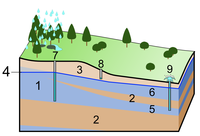
Efficient Removal of Methylene Blue by Novel Magnetic Hydrogel Nanocomposites of Poly(acrylic acid)
Sign Up to like & getrecommendations! Published in 2018 at "Advances in Polymer Technology"
DOI: 10.1002/adv.21665
Abstract: In the current research, the sonochemically prepared magnetite nanoparticles (MNPs) were silylated with triethoxyvinylsilane to produce a core–shell structure containing vinyl moieties on the surface. The radical polymerization of the silylated product with acrylic acid… read more here.
Keywords: adsorption; hydrogel; novel magnetic; acrylic acid ... See more keywords

Rheological study on the thermoinduced gelation behavior of poly(N‐isopropylacrylamide‐co‐acrylic acid) microgel suspensions
Sign Up to like & getrecommendations! Published in 2017 at "Journal of Applied Polymer Science"
DOI: 10.1002/app.45259
Abstract: Submicron-sized thermoresponsive poly(N-isopropylacrylamide-co-acrylic acid) microgels were synthesized by soap-free emulsion polymerization. The physical state of the microgel suspensions, in a wide range of polymer concentrations (1.1–7.1 wt %), transformed from fluid to gel when the… read more here.
Keywords: isopropylacrylamide acrylic; gelation; microgel suspensions; acrylic acid ... See more keywords

Terminal Alkenes from Acrylic Acid Derivatives via Non‐Oxidative Enzymatic Decarboxylation by Ferulic Acid Decarboxylases
Sign Up to like & getrecommendations! Published in 2018 at "Chemcatchem"
DOI: 10.1002/cctc.201800643
Abstract: Fungal ferulic acid decarboxylases (FDCs) belong to the UbiD‐family of enzymes and catalyse the reversible (de)carboxylation of cinnamic acid derivatives through the use of a prenylated flavin cofactor. The latter is synthesised by the flavin… read more here.
Keywords: acid decarboxylases; decarboxylation; acrylic acid; ferulic acid ... See more keywords

Mechanistic Study on the Selective Oxidation of Acrolein to Acrylic Acid concerning the Role of Water
Sign Up to like & getrecommendations! Published in 2020 at "ChemCatChem"
DOI: 10.1002/cctc.201902348
Abstract: The activity of Mo/V/W mixed oxide catalyst in the gas phase oxidation of acrolein to acrylic acid is tremendously influenced by addition of fed water. This effect of water is investigated and connected to the… read more here.
Keywords: oxidation; water; acrylic acid; mechanistic study ... See more keywords

Controlled release of an optically active compound by hydrogels of acrylic acid and its on-line detection
Sign Up to like & getrecommendations! Published in 2018 at "Canadian Journal of Chemical Engineering"
DOI: 10.1002/cjce.23038
Abstract: Hydrogels of acrylic acid were produced through solution free radical polymerization at 70 °C. The materials obtained were put in contact with D-fructose solution and the swelling behaviour was registered. The swollen hydrogels were immersed in… read more here.
Keywords: optically active; detection; controlled release; release optically ... See more keywords

Catalytic Cracking of Lactide and Poly(Lactic Acid) to Acrylic Acid at Low Temperatures
Sign Up to like & getrecommendations! Published in 2017 at "Chemsuschem"
DOI: 10.1002/cssc.201700108
Abstract: Abstract Despite being a simple dehydration reaction, the industrially relevant conversion of lactic acid to acrylic acid is particularly challenging. For the first time, the catalytic cracking of lactide and poly(lactic acid) to acrylic acid… read more here.
Keywords: catalytic cracking; acid acrylic; acrylic acid; cracking lactide ... See more keywords

Poly(DL-Lactide-co-ε-Caprolactone)/Poly(Acrylic Acid) Composite Implant for Controlled Delivery of Cationic Drugs.
Sign Up to like & getrecommendations! Published in 2019 at "Macromolecular bioscience"
DOI: 10.1002/mabi.201800322
Abstract: Poly(DL-lactide-co-ε-caprolactone)/poly(acrylic acid) implantable composite reservoirs for cationic drugs are synthesized by sequentially applying photoirradiation and liquid phase inversion. The chemical composition and microstructure of reservoirs are characterized with Fourier transform infrared spectroscopy-attenuated total reflection (FTIR-ATR)… read more here.
Keywords: poly lactide; poly acrylic; acrylic acid; lactide caprolactone ... See more keywords

Thermoresponsive UCST-Type Behavior of Interpolymer Complexes of Poly(ethylene glycol) and Poly(poly(ethylene glycol) methacrylate) Brushes with Poly(acrylic acid) in Isopropanol
Sign Up to like & getrecommendations! Published in 2017 at "Macromolecular Chemistry and Physics"
DOI: 10.1002/macp.201600466
Abstract: Upper critical solution temperature (UCST)-type thermoresponsive behavior of poly(ethylene glycol)-poly(acrylic acid) (PEG-PAA) and poly(poly(ethylene glycol) methacrylate)-poly(acrylic acid) (PPEGMA-PAA) interpolymer complexes has been observed in isopropanol. For these investigations, PPEGMA and PAA with various average molecular… read more here.
Keywords: interpolymer complexes; acrylic acid; poly ethylene; ethylene glycol ... See more keywords

Adaptation and Recovery of A Styrene-Acrylic Acid Copolymer Surface to Water.
Sign Up to like & getrecommendations! Published in 2022 at "Macromolecular rapid communications"
DOI: 10.1002/marc.202100733
Abstract: Drops sliding down an adaptive surface lead to changes of the dynamic contact angles. Two adaptation processes play a role: (i) the adaptation of the surface upon bringing it into contact to the drop (wetting)… read more here.
Keywords: adaptation; water; surface; styrene acrylic ... See more keywords

Synthesis and Biodegradation Studies of Low-Dispersity Poly(Acrylic Acid).
Sign Up to like & getrecommendations! Published in 2022 at "Macromolecular rapid communications"
DOI: 10.1002/marc.202100773
Abstract: Poly(acrylic acid) (PAA) is produced on an industrial scale and widely-used in applications such as personal care products and cleaning formulations that end up "down-the-drain." Relatively high molecular weight PAA is considered poorly biodegradable, but… read more here.
Keywords: paa; synthesis; molecular weight; acrylic acid ... See more keywords

Poly(acrylic acid)-Assisted Intrafibrillar Mineralization of Type I Collagen-A Review.
Sign Up to like & getrecommendations! Published in 2023 at "Macromolecular rapid communications"
DOI: 10.1002/marc.202200827
Abstract: The mineralization of type I collagen is a biological process occurring in vertebrates by which some hard tissues such as bone and dentin are constructed. Due to the extensive clinical needs for bone defect repair… read more here.
Keywords: type collagen; mineralization type; collagen; acrylic acid ... See more keywords